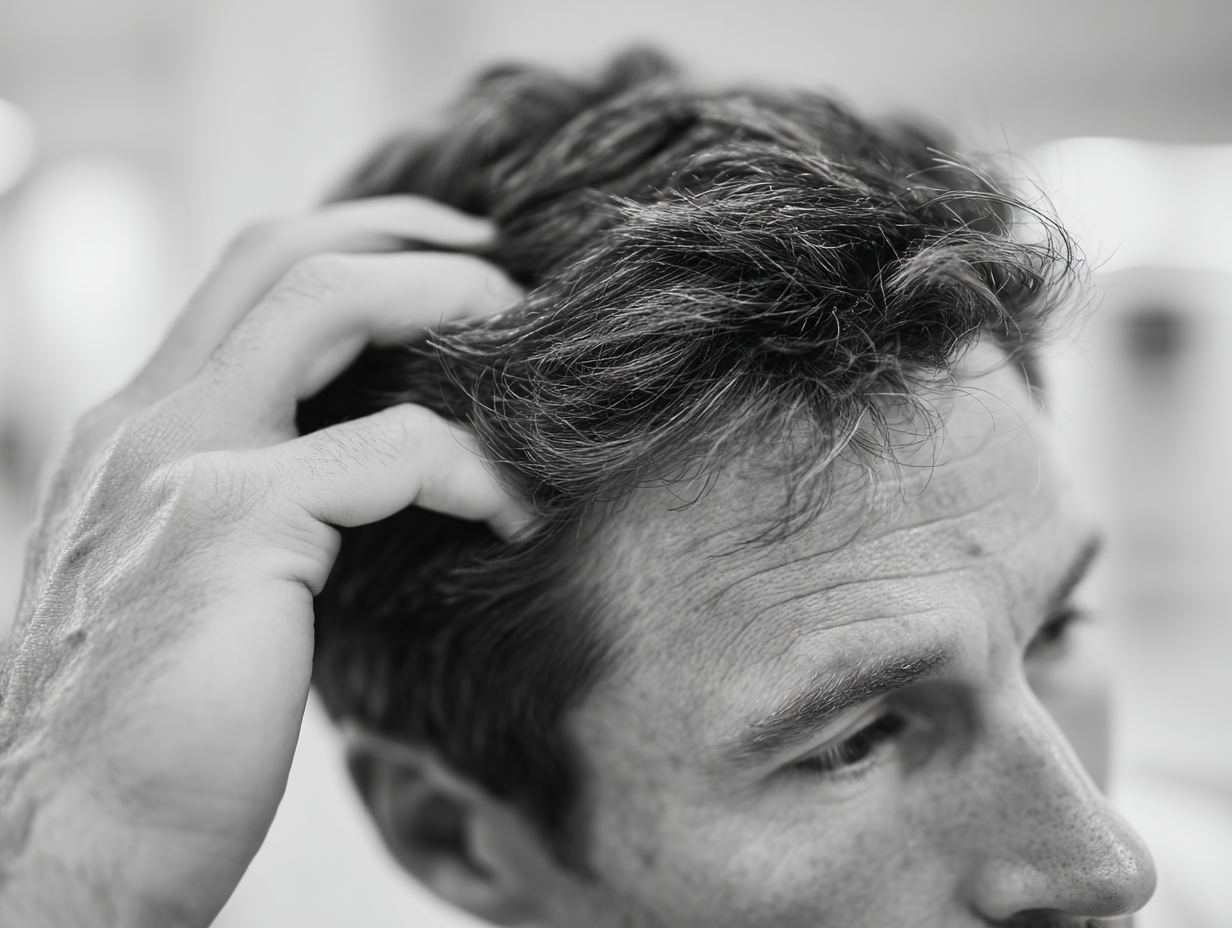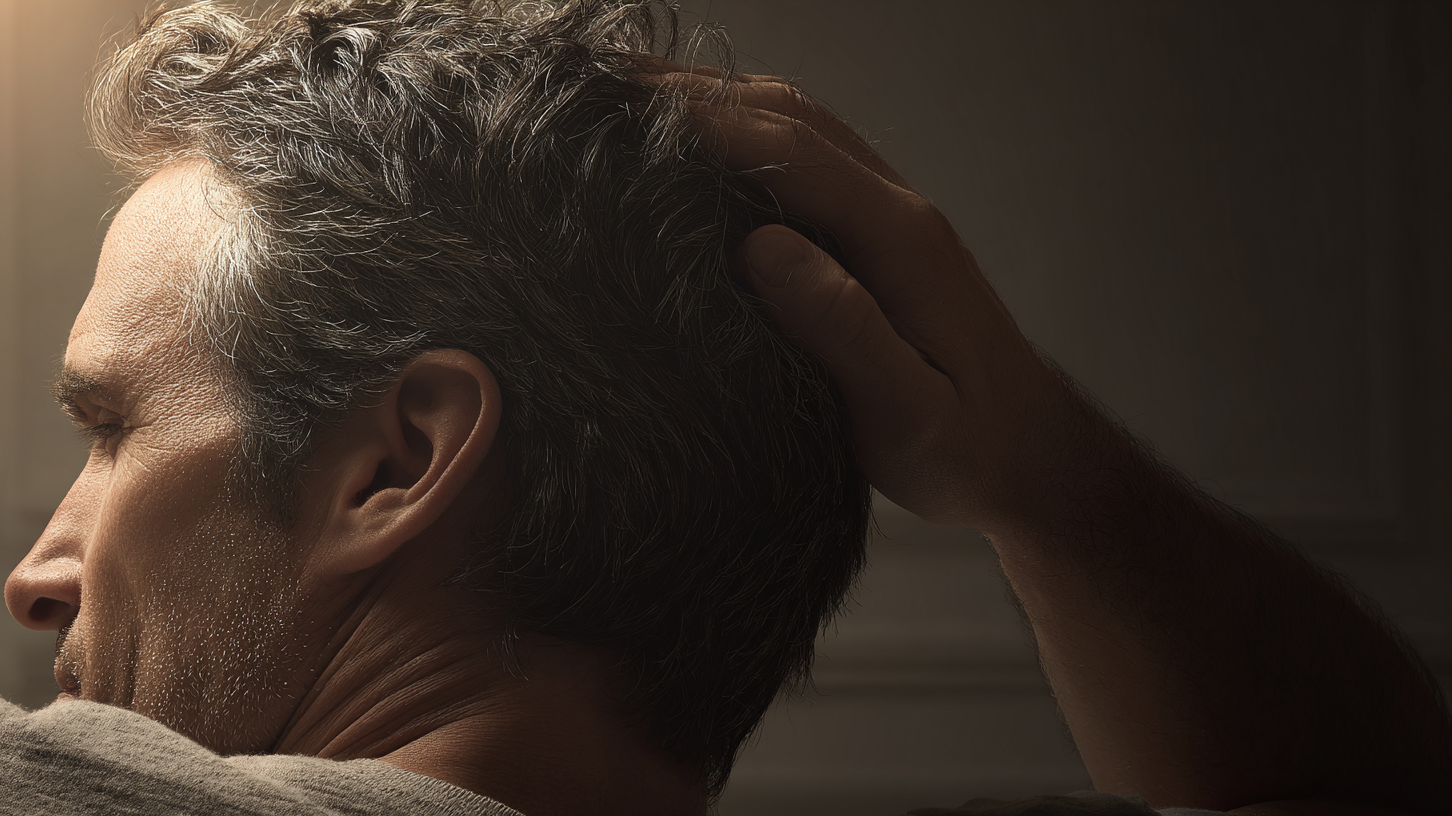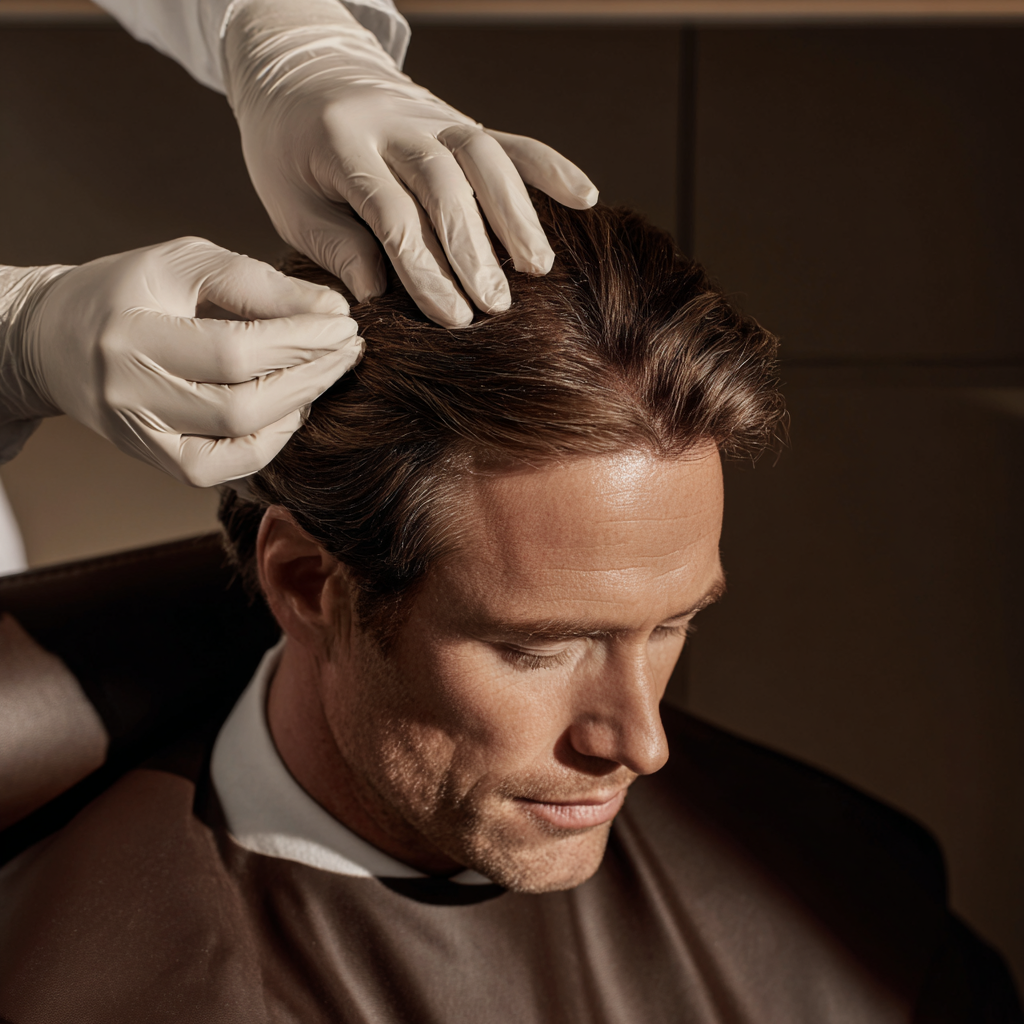Regenerate & Restore: Inside Paragon's PRP Hair Therapy
Harness your body's natural growth factors to stimulate hair follicles, increase hair density, and restore fuller, healthier hair growth. PRP (Platelet-Rich Plasma) for hair restoration uses concentrated platelets from your own blood – delivering powerful growth factors directly to weakened follicles to reverse miniaturization and reactivate dormant hair growth. Each treatment is precisely administered by our medical providers using advanced preparation techniques, designed to address the root cause of thinning hair and help you regain the confidence that comes with a fuller head of hair.

Biology, Growth
Factors and Hair Renewal
At Paragon Sports Medicine, we understand that hair loss affects more than appearance – it impacts confidence and self-image. PRP therapy for hair restoration represents a scientifically validated approach to combating androgenetic alopecia (pattern hair loss) and other forms of hair thinning. By concentrating platelets and their growth factors to 5-10 times normal blood levels, PRP creates an optimal biological environment for hair follicle regeneration. When injected into the scalp at precise depths, these growth factors prolong the anagen (growth) phase of the hair cycle, increase follicle size, stimulate stem cells in the follicle bulge, and improve blood supply to miniaturized follicles. The result is not overnight hair regrowth, but progressive improvement in hair density, thickness, and overall scalp health over 3-6 months of treatment.

The Science of
Follicle Regeneration
PRP therapy activates multiple biological pathways to reverse hair follicle miniaturization and stimulate new growth. The mechanism is supported by extensive clinical research:
Growth Factor Delivery
PRP contains over 20 different growth factors including PDGF, VEGF, EGF, and FGF that directly stimulate hair follicle stem cells and dermal papilla cells responsible for hair production.
Follicle Miniaturization Reversal
Growth factors counteract the effects of DHT (dihydrotestosterone) on hair follicles, reversing the progressive shrinking that characterizes pattern hair loss.
Anagen Phase Prolongation
PRP extends the active growth phase of the hair cycle while shortening the resting (telogen) phase, allowing hairs to grow longer and thicker before shedding.
Neovascularization & Nutrient Supply
VEGF and other angiogenic factors improve blood vessel formation around follicles, enhancing nutrient and oxygen delivery to support robust hair growth.
Stem Cell Activation
PRP awakens dormant follicular stem cells in the bulge region, stimulating them to regenerate new hair follicles and reactivate miniaturized ones.




From Early Thinning to Advanced Hair Loss:
PRP Applications
Whether you're noticing the first signs of thinning or addressing more significant hair loss, PRP offers a non-surgical, evidence-based solution. Multiple systematic reviews and meta-analyses demonstrate PRP's effectiveness for androgenetic alopecia, with studies showing 30-40% increase in hair density and significant improvements in hair diameter and growth rate. Clinical trials report that 70-80% of patients experience measurable improvement in hair count, thickness, or both after a series of treatments. Unlike topical treatments that require daily application indefinitely, PRP addresses hair loss at the follicular level through periodic treatments. Most patients notice reduced shedding within 2-3 months, with visible improvements in density and coverage appearing at 4-6 months and continuing to progress through 9-12 months.
PRP hair restoration has demonstrated significant effectiveness across multiple hair loss conditions:
%20(pattern%20baldness%2C%20crown%20thinning).png)
Androgenetic Alopecia (Male) (pattern baldness, crown thinning)
Addressing male pattern hair loss in early to moderate stages, slowing progression of crown and vertex thinning, improving density in areas of active miniaturization
%20(diffuse%20thinning%2C%20widening%20part).png)
Androgenetic Alopecia (Female) (diffuse thinning, widening part)
Treating female pattern hair loss with diffuse thinning, reversing progressive widening of the central part, increasing overall scalp coverage and hair density

Hair Quality & Maintenance (texture, strength, growth optimization)
Improving hair shaft thickness and strength, enhancing overall scalp health and follicle function, maintaining results in patients on finasteride or minoxidil
The PRP Hair Procedure:
Targeted Delivery. Biological Precision.
Blood Collection & Processing
A small blood sample is drawn and processed in a medical-grade centrifuge to isolate and concentrate platelets to therapeutic levels (typically 5-10x baseline concentration).

Scalp Assessment & Preparation
Your provider evaluates your pattern of hair loss, identifies treatment zones, and cleanses the scalp. Optional nerve blocks or topical anesthesia may be applied for comfort.

PRP Activation & Preparation
The concentrated PRP is activated to release growth factors and may be combined with additives to enhance efficacy and extend bioavailability of growth factors.

Precise Scalp Injection
Using fine needles, PRP is injected throughout areas of thinning at the precise dermal depth where follicles reside (typically 2-3mm), ensuring optimal growth factor delivery to target tissue.

Post-Treatment Protocol & Planning
You'll receive instructions for gentle scalp care, activity modifications for 24-48 hours, and scheduling for your treatment series to optimize follicle response and hair regrowth.


Expertise That Drives Results
PRP effectiveness for hair restoration varies significantly based on preparation and technique. Success requires three essential elements:
With extensive experience in regenerative medicine and a commitment to evidence-based protocols, our providers deliver the technical precision and comprehensive care that separate meaningful hair restoration from disappointing outcomes.
Why Choose PRP for Hair Regrowth

Non-Surgical & Minimally Invasive
An office-based procedure requiring no incisions, general anesthesia, or surgical recovery. Unlike hair transplant surgery, there are no linear scars, no donor site depletion, and minimal downtime.
Scientifically Validated Effectiveness
Multiple systematic reviews and clinical trials demonstrate significant improvements in hair density, hair count, and hair shaft diameter with PRP therapy for androgenetic alopecia.
Natural & Biocompatible
Because PRP uses your own blood components, there's virtually no risk of allergic reaction or rejection. No foreign substances or synthetic materials – just your body's own growth factors concentrated and delivered to follicles.
Addresses Underlying Follicle Dysfunction
Rather than simply covering bald areas or masking symptoms, PRP treats the biological dysfunction occurring within miniaturized follicles – reversing damage at the cellular level.
Synergistic with Other Treatments
PRP enhances the effectiveness of minoxidil and finasteride, can improve outcomes from hair transplant procedures, and works synergistically with other regenerative therapies for comprehensive hair restoration.
FREQUENTLY ASKED QUESTIONS:
About PRP Hair Restoration
Multiple systematic reviews and meta-analyses support PRP's effectiveness for androgenetic alopecia. A 2019 meta-analysis in Aesthetic Plastic Surgery reviewed 11 studies and found significant increases in hair density, hair count, and hair thickness with PRP treatment. Studies consistently show 30-40% increases in hair density and 20-30% increases in hair diameter after a treatment series. The 2020 international consensus statement on PRP for hair loss concluded that PRP is an effective, evidence-based treatment for androgenetic alopecia when proper protocols are followed. While not every patient achieves the same degree of improvement, clinical evidence demonstrates that 70-80% of appropriately selected patients experience measurable benefits.
Ideal candidates are men and women with early to moderate androgenetic alopecia (pattern hair loss) who still have active follicles in thinning areas. PRP works best when follicles are miniaturized but not completely dormant – it cannot resurrect follicles that have been dead for years. The best responders are typically those with Ludwig Grade I-II (women) or Norwood Grade II-V (men). PRP can also benefit patients experiencing hair loss from other causes like stress, inflammation, or as maintenance therapy for those on medical treatments. You should be in good general health without blood disorders or active scalp infections. The best way to determine candidacy is through comprehensive evaluation of your hair loss pattern and scalp health.
Most patients require an initial series of 3-4 treatments spaced 4-6 weeks apart to achieve optimal follicle stimulation. This initial intensive phase is crucial for reversing miniaturization and initiating new growth. After the initial series, maintenance treatments every 4-6 months help sustain results and prevent progression of hair loss. Some patients with more advanced thinning may benefit from additional sessions in the initial series. During consultation, your provider will assess your degree of hair loss and recommend a personalized treatment protocol based on clinical evidence and your specific condition.
Hair regrowth is a biological process that requires patience. Most patients notice reduced hair shedding around 2-3 months after beginning treatment – often the first sign that follicles are responding. Visible improvements in hair density and coverage typically appear at 4-6 months, with progressive enhancement continuing through 9-12 months as dormant follicles enter the growth phase and miniaturized hairs become thicker. Unlike instant cosmetic procedures, PRP stimulates natural biological processes that take time to manifest. Before-and-after photos taken at 6-month intervals provide the best documentation of progressive improvement. Results continue to develop with maintenance treatments.
Most patients tolerate the procedure well with appropriate anesthesia. We can apply topical numbing cream to the scalp before treatment, and some patients benefit from scalp nerve blocks for additional comfort. The injections themselves involve multiple needle sticks across the treatment area, which can cause temporary discomfort or stinging. Most patients describe it as tolerable pressure and mild burning rather than severe pain. Discomfort is brief and subsides quickly after the procedure. Some patients experience mild scalp tenderness for 1-2 days following treatment, similar to mild sunburn sensation.
Absolutely – in fact, combining treatments often produces superior results. Clinical studies demonstrate that PRP enhances the effectiveness of minoxidil (Rogaine), and many dermatologists recommend continuing minoxidil during PRP therapy. Finasteride (Propecia) works through a different mechanism (blocking DHT conversion) and complements PRP's growth factor stimulation. PRP can also improve healing and graft survival when performed before or after hair transplant surgery. Your provider can develop an integrated treatment plan that leverages multiple therapeutic approaches for optimal hair restoration outcomes.
PRP is not a permanent cure for androgenetic alopecia – it's a therapeutic intervention that requires maintenance. The initial series of 3-4 treatments can produce improvements that last 12-18 months, but because pattern hair loss is a progressive condition, maintenance treatments every 4-6 months are typically needed to sustain results and prevent further thinning. Think of PRP like physical therapy for your follicles – initial intensive treatment creates improvement, but ongoing maintenance preserves gains. Some patients achieve stable results with annual maintenance, while others require more frequent treatments depending on their degree of hair loss and genetic factors.
Immediately after treatment, your scalp may appear pink or red with small injection marks – similar to microneedling appearance. This typically resolves within 24 hours. Some patients experience mild scalp tenderness, tightness, or sensitivity for 1-2 days. We recommend avoiding washing your hair for 12-24 hours, avoiding strenuous exercise for 24 hours, and avoiding harsh chemical treatments or coloring for one week. You may notice temporary increased shedding 2-4 weeks after treatment – this is normal and often indicates follicles transitioning from resting to growth phase. Most patients return to all normal activities within 24-48 hours.
PRP for hair restoration is very safe when performed by trained medical providers. Because it uses your own blood components, allergic reactions are extremely rare. Common side effects are mild and temporary: scalp tenderness, redness, mild swelling, or small bruises at injection sites lasting 1-3 days. Some patients experience temporary increased shedding in the first month (shedding of telogen hairs to make room for new growth). Serious complications are extremely rare but can include infection, nerve injury, or blood vessel injury with improper technique. Patients with blood disorders, active infections, or those on certain anticoagulant medications may not be appropriate candidates. We'll review your complete medical history during consultation to ensure safety.
PRP effectiveness depends on multiple factors. Common reasons for suboptimal results include: (1) inadequate PRP concentration or preparation – not all PRP systems achieve therapeutic platelet levels; (2) treating completely dormant follicles that are beyond recovery; (3) insufficient number of treatments or inappropriate spacing; (4) underlying medical issues like significant nutritional deficiencies, thyroid disorders, or severe inflammation; (5) unrealistic expectations – PRP improves density and thickness but rarely restores hair to teenage levels in advanced baldness; (6) failure to maintain results with periodic treatments. This is why choosing experienced providers who follow evidence-based protocols and conduct thorough evaluations is crucial for achieving meaningful outcomes.
Multiple systematic reviews and meta-analyses support PRP's effectiveness for androgenetic alopecia. A 2019 meta-analysis in Aesthetic Plastic Surgery reviewed 11 studies and found significant increases in hair density, hair count, and hair thickness with PRP treatment. Studies consistently show 30-40% increases in hair density and 20-30% increases in hair diameter after a treatment series. The 2020 international consensus statement on PRP for hair loss concluded that PRP is an effective, evidence-based treatment for androgenetic alopecia when proper protocols are followed. While not every patient achieves the same degree of improvement, clinical evidence demonstrates that 70-80% of appropriately selected patients experience measurable benefits.
Ideal candidates are men and women with early to moderate androgenetic alopecia (pattern hair loss) who still have active follicles in thinning areas. PRP works best when follicles are miniaturized but not completely dormant – it cannot resurrect follicles that have been dead for years. The best responders are typically those with Ludwig Grade I-II (women) or Norwood Grade II-V (men). PRP can also benefit patients experiencing hair loss from other causes like stress, inflammation, or as maintenance therapy for those on medical treatments. You should be in good general health without blood disorders or active scalp infections. The best way to determine candidacy is through comprehensive evaluation of your hair loss pattern and scalp health.
Most patients require an initial series of 3-4 treatments spaced 4-6 weeks apart to achieve optimal follicle stimulation. This initial intensive phase is crucial for reversing miniaturization and initiating new growth. After the initial series, maintenance treatments every 4-6 months help sustain results and prevent progression of hair loss. Some patients with more advanced thinning may benefit from additional sessions in the initial series. During consultation, your provider will assess your degree of hair loss and recommend a personalized treatment protocol based on clinical evidence and your specific condition.
Hair regrowth is a biological process that requires patience. Most patients notice reduced hair shedding around 2-3 months after beginning treatment – often the first sign that follicles are responding. Visible improvements in hair density and coverage typically appear at 4-6 months, with progressive enhancement continuing through 9-12 months as dormant follicles enter the growth phase and miniaturized hairs become thicker. Unlike instant cosmetic procedures, PRP stimulates natural biological processes that take time to manifest. Before-and-after photos taken at 6-month intervals provide the best documentation of progressive improvement. Results continue to develop with maintenance treatments.
Most patients tolerate the procedure well with appropriate anesthesia. We can apply topical numbing cream to the scalp before treatment, and some patients benefit from scalp nerve blocks for additional comfort. The injections themselves involve multiple needle sticks across the treatment area, which can cause temporary discomfort or stinging. Most patients describe it as tolerable pressure and mild burning rather than severe pain. Discomfort is brief and subsides quickly after the procedure. Some patients experience mild scalp tenderness for 1-2 days following treatment, similar to mild sunburn sensation.
Absolutely – in fact, combining treatments often produces superior results. Clinical studies demonstrate that PRP enhances the effectiveness of minoxidil (Rogaine), and many dermatologists recommend continuing minoxidil during PRP therapy. Finasteride (Propecia) works through a different mechanism (blocking DHT conversion) and complements PRP's growth factor stimulation. PRP can also improve healing and graft survival when performed before or after hair transplant surgery. Your provider can develop an integrated treatment plan that leverages multiple therapeutic approaches for optimal hair restoration outcomes.
PRP is not a permanent cure for androgenetic alopecia – it's a therapeutic intervention that requires maintenance. The initial series of 3-4 treatments can produce improvements that last 12-18 months, but because pattern hair loss is a progressive condition, maintenance treatments every 4-6 months are typically needed to sustain results and prevent further thinning. Think of PRP like physical therapy for your follicles – initial intensive treatment creates improvement, but ongoing maintenance preserves gains. Some patients achieve stable results with annual maintenance, while others require more frequent treatments depending on their degree of hair loss and genetic factors.
Immediately after treatment, your scalp may appear pink or red with small injection marks – similar to microneedling appearance. This typically resolves within 24 hours. Some patients experience mild scalp tenderness, tightness, or sensitivity for 1-2 days. We recommend avoiding washing your hair for 12-24 hours, avoiding strenuous exercise for 24 hours, and avoiding harsh chemical treatments or coloring for one week. You may notice temporary increased shedding 2-4 weeks after treatment – this is normal and often indicates follicles transitioning from resting to growth phase. Most patients return to all normal activities within 24-48 hours.
PRP for hair restoration is very safe when performed by trained medical providers. Because it uses your own blood components, allergic reactions are extremely rare. Common side effects are mild and temporary: scalp tenderness, redness, mild swelling, or small bruises at injection sites lasting 1-3 days. Some patients experience temporary increased shedding in the first month (shedding of telogen hairs to make room for new growth). Serious complications are extremely rare but can include infection, nerve injury, or blood vessel injury with improper technique. Patients with blood disorders, active infections, or those on certain anticoagulant medications may not be appropriate candidates. We'll review your complete medical history during consultation to ensure safety.
PRP effectiveness depends on multiple factors. Common reasons for suboptimal results include: (1) inadequate PRP concentration or preparation – not all PRP systems achieve therapeutic platelet levels; (2) treating completely dormant follicles that are beyond recovery; (3) insufficient number of treatments or inappropriate spacing; (4) underlying medical issues like significant nutritional deficiencies, thyroid disorders, or severe inflammation; (5) unrealistic expectations – PRP improves density and thickness but rarely restores hair to teenage levels in advanced baldness; (6) failure to maintain results with periodic treatments. This is why choosing experienced providers who follow evidence-based protocols and conduct thorough evaluations is crucial for achieving meaningful outcomes.
Schedule a
consultation
We don't just treat hair loss – we address the biological dysfunction occurring within your follicles to stimulate natural regrowth. Whether you're experiencing early thinning or more advanced pattern hair loss, our PRP hair restoration treatments combine scientific evidence, proper technique, and comprehensive hair health management.
Our thorough approach evaluates your pattern of hair loss, assesses candidacy for PRP therapy, and develops a treatment protocol based on clinical research and proven results. Hair restoration here isn't just hopeful – it's scientifically grounded.
Schedule a
consultation
We don't just treat hair loss – we address the biological dysfunction occurring within your follicles to stimulate natural regrowth. Whether you're experiencing early thinning or more advanced pattern hair loss, our PRP hair restoration treatments combine scientific evidence, proper technique, and comprehensive hair health management.
Our thorough approach evaluates your pattern of hair loss, assesses candidacy for PRP therapy, and develops a treatment protocol based on clinical research and proven results. Hair restoration here isn't just hopeful – it's scientifically grounded.
